Hello everyone! Welcome back to the blog. I hope you have been enjoying the first few days of summer. I know I have been. Last weekend I was able to go camping for the first time this year and I really loved waking up to the sound of birds singing just outside my tent.
What birds have you been seeing lately? Have you noticed any changes in the types of bird visitors to your backyard? I had an exciting visitor last week that was a great surprise to me. I was sitting by the window and I heard a loud “EEE-EEE-EEE.” I quickly looked out and saw a Blue Jay in my vegetable garden. Blue Jays are a common backyard bird but I haven’t seen one in my yard since last year when a couple raised their young in my neighbours tree. But, they are back and I am so happy to have them around. They are now frequent fliers in my backyard. The one see most often can usually be seen on the top of the hydro pole, scanning the yard and making acrobatic manoeuvres through the trees. They are very observant birds, watching the goings-on in the yard and making targeted movements to their various destinations. Some of the smaller songbirds in my yard spend time flitting around and hopping from place to place, spending time casually feeding or having a dust bath, but the Blue Jays are focused on their objectives. Their large body size and strong wings make them powerful fliers and their high intelligence means that they have behaviours that are both clever and deceptive. Blue Jays are even known to mimic the calls of species like the Red-shouldered Hawk.
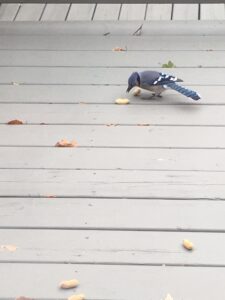
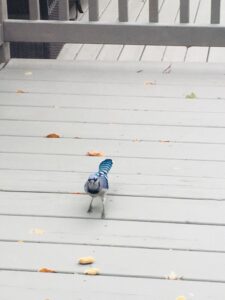
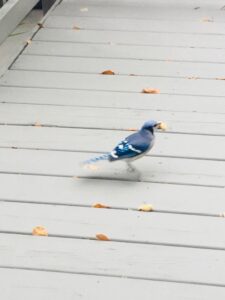
If you want to attract Blue Jays to your yard it’s pretty easy, if you have an oak tree, they might already be around since one of their favourite foods are acorns. If you don’t, then try putting some peanuts out for them, Blue Jays love peanuts. Try placing shelled peanuts in a row on your fence or deck and you might see them come and weigh the nuts to claim the meatiest one. They have been observed to pick up and shake the peanuts before deciding on which one to take with them.
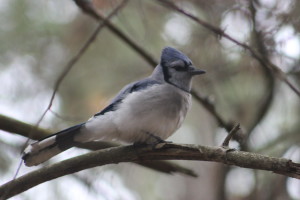
Besides being clever birds, Blue Jays also have a stunning plumage and distinctive markings. Their blue body, pointy crest and black and white mask around their faces make them unmistakable. Some scientists believe that the variations in facial markings make it easier for them to identify each other. To be honest, I haven’t been able to distinguish whether or not there is more than on Blue Jay in my yard, since I only see one at a time, but I am trying to look closely at the facial markings in hopes that I will be able to recognize different individuals who share my yard. Hopefully there are two, and if I’m really lucky there might be baby Blue Jays to watch in the near future.
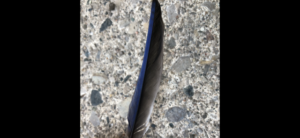
When I was outside today, a beautiful blue something caught my eye and I saw that a
Blue Jay had dropped a feather on the driveway. I was able to observe the feather up
close and saw that the blue colour is quite unique, it appears blue on the front and
brown on the back. When I did some research I learned that the blue colour we can
see is a trick of the light refracting off of the cells of the feather’s surface. Moving my
head to adjust the angle I saw the feather’s colour shift in vibrancy. How cool is that!
The melanin in the feather’s makeup works in a similar way to all other blue birds, like
Indigo Buntings and Bluebirds, whereas birds such as Baltimore Orioles and Northern Cardinals have orange or red pigment in their feathers produced by carotenoids rather than melanin.
I am learning more every day about the wonderful birds that surround me and I am
always delighted to make a new observation that helps me to peek inside the life of
birds. Everything becomes more magical when I gather a new piece of the puzzle that
helps me to relate more closely to the natural world. I’m so glad to share what I learn
with you and hope that you will share your bird stories with me too. Until next time,
happy birding!
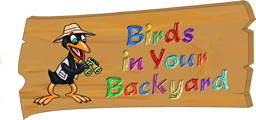
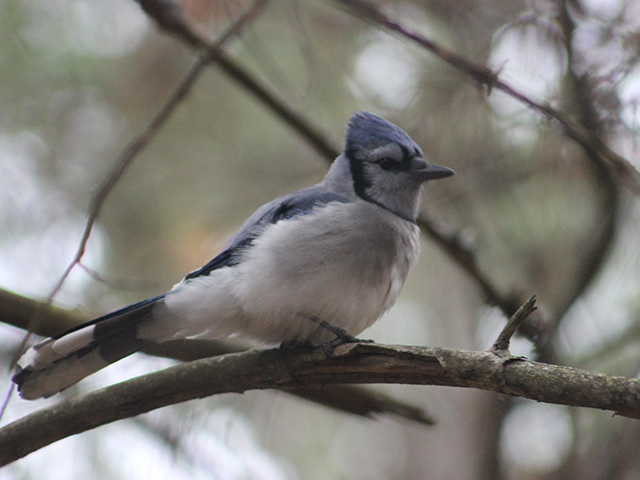
Recent Comments